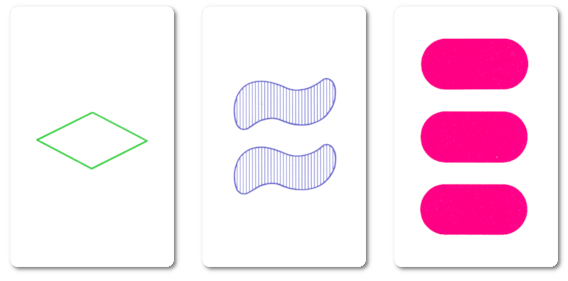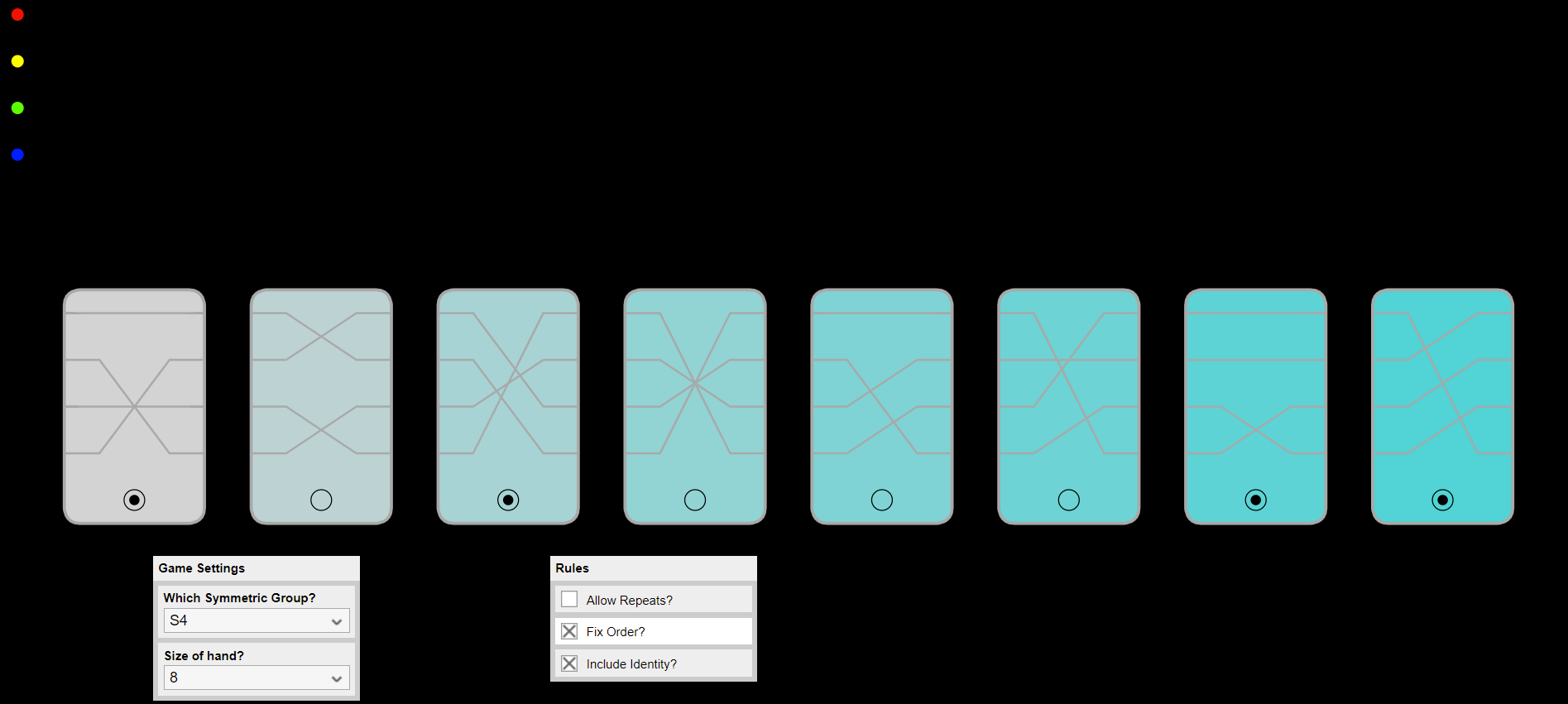Nonabelian Set

Below are my online implementations of the group theoretic generalization of SET, invented by Cathy Hsu, Jonah Otroff, and Lucas Van Meter. Click on one of the images to jump right in and play, or read on for more information.
The famous game of SET has a few interesting mathematical interpretations. It can be thought of as finding geometric patters (using tools of projective geometry), or as finding arithmetic ones (using tools of group theory). Fantastic work of Cathy Hsu, Jonah Otroff, and Lucas Van Meter, explores these perspectives, and creates really fun variations of the game in both directions. You can check out several of them here, and even find printable cards to play yourself. They wrote a pair of nice papers about the project. The first, regarding the geometric perspective, was the cover story for the Math Horizons April 2020 Issue. The second, regarding the group theoretic perspective, is to appire in the Math Horizons April 2021 Issue.
An example of the group theoretic perspective is a version which takes place in the symmetric group Sn, where the player combines permutations to get the identity. At ICERM's Illustrating Mathematics program we laser cut these permutations onto tiles to play with directly, and I would say that much fun was had. These tiles appear in the AMS book Illustrating Mathematics edited by Diana Davis.
When I was first asked what I thought about the game (at this point still in its paper variant), I suggested colors to more easily follows the lines, before I realized that on paper that wouldn't make sense. Apparently this was a common suggestion, so I went about trying to code it up in javascript. So far I have implented versions for 3 families of groups.
Symmetric Groups Sn
This first version is the standard symmetric group on n letters. Elements of these groups are permutations (bijective functions) on a set of n elements. The set here is represented by the n (colored) points on the left side of the board. The goal of the game is to choose 3 or more cards which together add up to the identity permutation. This should mean that after composing the 3 or more functions, each point (or color) should end up back where it started. Notice that (unlike regular set), the order that you choose your cards matters! This is why we call this nonabelian set! At the bottom of each card, there is either a dot or a circle. This represents the sign or parity of the permutation. The identity permutation is even, so this tells you that to win you must have an even number of filled dots on the bottom of the card. You can play S3, S4, and for a real challenge S5. I threw in S6 and S7, but I'm not convinced one should expect a winning hand on the board in these cases.
Products of Symmetric Groups Sn × Sm
A slight generalization of the above playing with direct products of symmetric groups. We often think of elements a direct product G × H of 2 groups as ordered pairs (a,b), where the first coordinate is an element of the first G, and the second is an element of H, where multiplication happens coordinatewise. In this version of the game we represent the first coordinate as the a permutation of the top set of points, and the second coordinate as a permutation on the bottom. The trick is to get both permtations to add up to the identity simultaneously.
As in the previous case, we give the parity of the permutations to help. The parity of the top permutation is represented by the (filled or not) diamond at the top, while the dot at the bottom represents the parity of the bottom permutation.
Wreath Products of Symmetric Groups with Cyclic Groups Sn ≀ Z2
The wreath product is a way to construct a new group from old groups together with a certain type of group action. In this example we consider the cyclic group of order 2 Z2 acting independently on each element of the set of n elements. The action on an element is represented by a dot on the card, and when the line passes through the dotted, it becomes a dashed line (or if it is already dashed it becomes solid). The goal is the same as the the variants above, compose to the identity element, but the Z2 action must be trivial as well! In the language of the game, not only must the colors end up correctly arranged, but all of the lines must end up solid rather than dashed.
There is one more link for you, but be warned, what follows is a work in progress, and I may accidentally push a buggy broken link online as I fiddle with it.
Adjustable Settings and Rules

Above is a version implementing the following variants of the game (all optional with the settings). One can choose to have no repeated cards, or to not have the identity card appear (although I rather like the identity card, it's kind of like a wildcard!). You can also adjust the size of your hand, or play a version of the game where the cards must remain in the same order in order to get a SET. In order to help keep track of the order when the cards are in play, I've implemented a colored gradient on the cardback whose saturation order must be preserved, but I don't think this is the best implementation. So far this is only running for the Sn version. If you find bugs, or have any suggestions, please do reach out. By clicking the link, you have become a beta tester!
All the code and documentation is available on github: HERE. To finish, I will include some pictures of the beautiful wooden tiles that were laser cut at ICERM.
